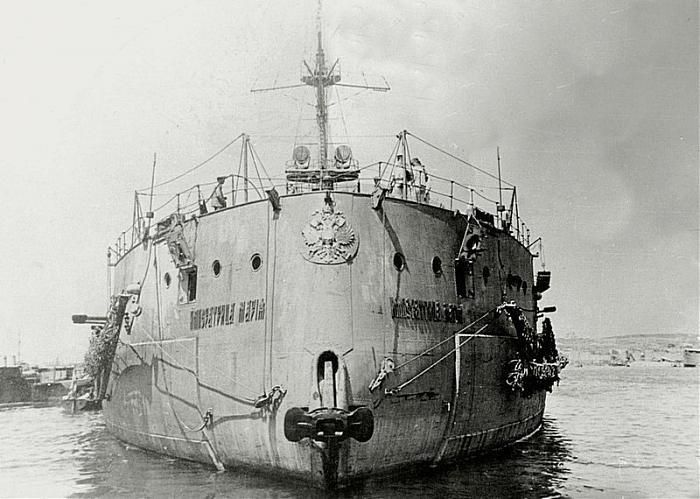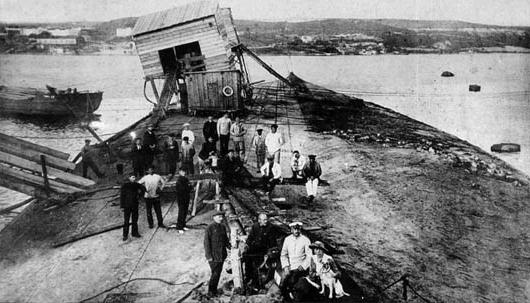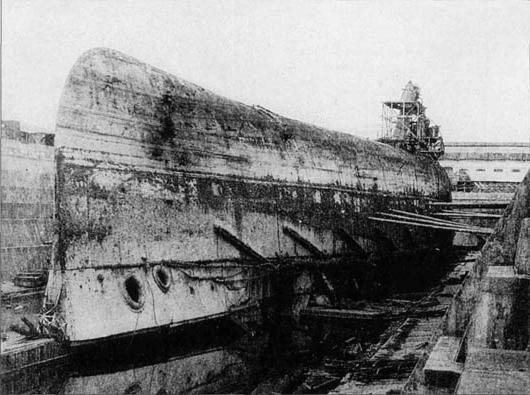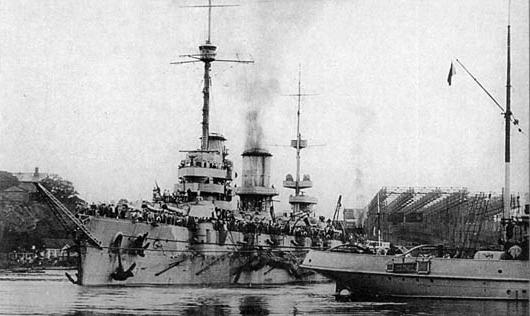The history of naval forces around the world is full of mysteries. Such a complex machine, like a warship, is full of equipment, weapons and machines, improper handling of which can lead to the death of the ship. But even this does not explain everything. The catastrophe is most often so fleeting and large-scale that there is no one to tell about all its circumstances. The debris is a pile of mangled metal, usually lying at the bottom, so the investigation and finding out the causes are extremely difficult. So it was with the Japanese ships Fuso, Congo, Mutsu, Yamato, the American dreadnought Arizona, the Italian cruiser Roma, the Soviet Marat, the British Barham and Hood. In the postwar period, the martyrology replenished with Novorossiysk. The death of the battleship “Empress Maria” in October 1916 may well be attributed to difficult to explain historical facts.
A series of the best battleships
Contrary to popular belief, the origin of which is explained by the specific approach of the Soviet party leaders to domestic pre-revolutionary history, the Russian Empire was not a backward country. The discoveries of our scientists forever entered the treasury of world science. Russian electrical engineers developed the world's first three-phase power supply system, invented an induction motor and wireless communications. All these achievements found their application in the construction of new ships of the Imperial Navy, launched in series in 1911. There were three of them: the battleship "Empress Maria" was the first of them. “Empress Catherine the Great” and “Emperor Alexander III” generally repeated his constructive decisions, although, as is most often the case, they were built taking into account new ideas arising during the production process. Already in the spring of 1914, the head unit was launched. It happened just in time. The World War, which seemed to start suddenly with the shots thundered in Sarajevo, was not really a surprise. Battleships of the type "Empress Maria" substantially balanced the balance of power in the proposed naval theater of operations. The Russian fleet healed the Tsushima wounds.
Porphyry name
A series of ships received the names of the royal persons of the Russian State. It is interesting that only the battleship Empress Maria of the Black Sea Fleet was named after the living, long-living widow of Alexander III, the born Danish princess Louise Sophia Frederika Dagmar, who became a real Russian patriot, by the way, despite her foreign origin. However, this has already happened, it is enough to recall Catherine the Great, whose name was given to another battleship of the same type. Without a doubt, this woman deserved such an honor, besides she was the mother of Nicholas II. Its role in Russian history is great, and the strength of character, kindness and righteousness of life successfully competed with external beauty.

The fate of Maria Fyodorovna is tragic, she died in her homeland, in Denmark (1928), while being in exile and personifying the share of all those Russians who happened to eat the bitter bread of a foreign land, “without leaving crusts”. And before that, she lost dear and close people: two sons, a daughter-in-law, four granddaughters and a grandson.
Ship characteristics
The battleship Empress Maria was an outstanding ship in every respect. He walked swiftly, developing a speed of almost 24 knots (about 40 km / h) with a load of 2 thousand tons of coal and 600 tons of fuel oil, had autonomy for eight days, the team consisted of 1260 sailors and officers. The power plant is a turbine type, it consisted of two cars of 10,000 liters each. from.

Battleships are a special type of naval equipment, they are distinguished by a high level of artillery armament. Four gun turrets were equipped with three 12-inch guns (produced by the famous Obukhov plant) each. In addition to the main caliber, an auxiliary caliber was introduced, in the amount of 32 pcs. These guns had different purposes, including anti-aircraft guns, which indicated the ability of Russian engineers to think promisingly and take into account the growing threat of an air attack. There was another design feature that distinguished the battleship "Empress Maria." Drawings of superstructures were made taking into account the maximum increase in the firing sector, so the power of the volley depended little on the angle of the target in relation to the course.
The outputs of the torpedo tubes were located below the waterline, which was a revolutionary achievement at that time. A layer of armor 250 mm thick girdled the hull, and the deck was protected by it. The ship’s power supply system deserves special words. The battleship “Empress Maria” was powered by six dynamo machines (today they are called generators). All heavy mechanisms were rotated by electric motors, in particular, there were 22 pieces on each artillery tower.
Such a ship could carry out combat missions even in our time.
How the battleship fought
In the fall of 1915, the intensity of sea battles in the Black Sea reached a peak. Turkey, an ally of Austria-Hungary, showed regional activity, the German submarine fleet was no less aggressive. In response, the Black Sea Fleet artillery bombarded the ports of the northern Ottoman coast - Eregli, Kilimli, Zunguldak and Kozlu. On the flagship battleship, "Mary", Admiral Kolchak managed the naval operations. On the account of the team appeared all new sunk enemy ships. The German cruiser "Breslau", rushing to the aid of the Turkish fleet, in February was unable to fulfill the task and barely came off the Russian battleship, having received multiple injuries. For the whole of 1916, another German raider, "Gabin," only ventured three times into the Black Sea basin from the Bosphorus, for a while and without success. The battleship Empress Maria returned from her last trip to the Sevastopol Bay on October 6, 1916.
Victims and survivors
Unlike many other marine disasters, in this large part of the team managed to survive. Of the 1260 crew members, according to various sources, between 152 and 216 people died immediately. The number of wounded and burned ranged from one and a half hundred to 232 people. Despite the urgent medical assistance provided, another hundred and fifty sailors died in hospitals. Thus, the death of the battleship “Empress Maria” caused the death of three hundred and fifty people (according to the maximum estimate), which is approximately 28% of the entire team. There could have been much more victims, but, fortunately, almost all sailors who did not do duty duty participated in the prayer service that took place on the aft deck. What is called, God saved.
Eyewitness accounts
The surviving crew members told what happened on the battleship in the early morning of October 7th. In a sense, the whole Sevastopol awakened by a terrible roar can be called a witness. People who accidentally saw the whole picture of the disaster from the shore and other Black Sea Fleet ships claim that the very first explosion detonated the foremast, the front pipe and the conning tower. But the main reason why the struggle for life was useless was the destruction of the hull, resulting in a rupture of the side to a level below the waterline, after which the seawater began to flow into the compartments. The fire, meanwhile, continued. In a matter of minutes, the commander of the Black Sea Fleet, Admiral Kolchak, arrived on the ship to supervise the rescue operations, fire boats and tugboats arrived in time, but there was nothing to be done. In less than an hour, the ammunition in the cellar of the bow tower detonated, several more explosions were heard, the battleship received negative buoyancy, the overclock turned over and sank.

Fight for survivability
Sailors throughout the disaster acted in accordance with the Charter and performed duties as ordered by the staffing table. At 7:20 the sailors of the fourth casemate, who were on duty, noticed a strange hiss coming from behind the partition of the cellar of the bow tower adjacent to them. They immediately reported to their immediate superior what was happening, managed to roll out fire hoses and supplied water. It took only two minutes. Sailors who changed after a shift at that time washed themselves before rest, all of them were burned by the infernal flame of an explosion. The power supply was interrupted, the light went out. The explosions continued (a total of 25 thundered), detonated 130-mm caliber shells. Meanwhile, by order of a senior mechanical engineer, midshipman Ignatiev tried to start fire pumps. He did not succeed, the brave sailor died. An attempt to flood the cellars of the second bow tower to create a water barrier was also unsuccessful, it simply did not have enough time. Realizing that everyone could not be saved, the commanders gave the command to the sailors to leave, and themselves remained to certain death, trying to fulfill their duty. After lifting the ship, the remains of heroes were found and buried ...

Main version: accident
People tend to look for clues to everything inexplicable. The more mysterious the circumstances, the more complicated and confusing they are usually interpreted. Therefore, the official version of the commission of inquiry that the explosion on the flagship of the Black Sea Fleet occurred due to self-ignition of airborne powder vapors, was disappointing for many. Nevertheless, most likely it was. The shells for a long time along with the caps were in the trunks, especially when the battleship hunted for the "Gabin", and this could provoke detonation. But there is another version, according to which the mysterious death of the battleship "Empress Maria" did not happen by accident.
German spies
Some circumstances also favor the “sabotage” hypothesis. The ship was undergoing repairs, access control was weak, and what could have prevented the scout from putting a micro-fuse in the cellar, similar to that found on the Italian dreadnought Leonardo da Vinci in the summer of 1915? Moreover, many hatches did not lock. Another fact speaks at first glance in favor of espionage sabotage: in 1933, the NKVD bodies neutralized the German intelligence station, led by a certain Verman. According to the arrested, he was recruited before the revolution. And he was interested in the achievements of the military Russian electrical engineering, including the schemes of the “Empress Mary”. Then the KGB did not give attention to this. Was Verman a spy, it is not known, then people admitted to anything.

The ship was cut into scrap metal in 1926. All that remains is the memory of what the battleship Empress Maria was like. His model is in the Nakhimov Museum, in the homeland of the naval commander - in the Smolensk region. Another skillfully executed model - on a large scale - decorates the exposition of the Nikolaev Museum of the History of Shipbuilding and the Navy.